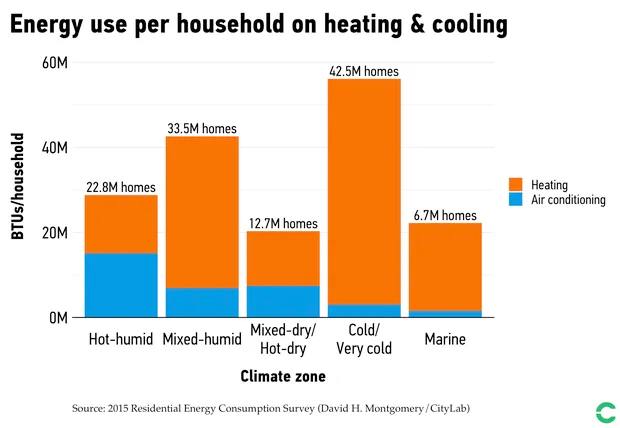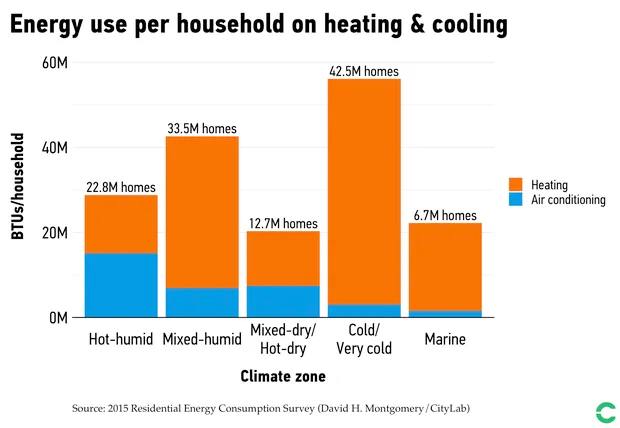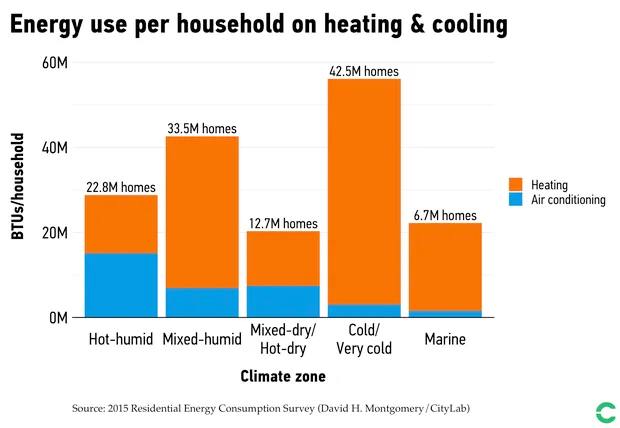Humans probably shouldn’t be living in these conditions if they can’t survive without AC, no?
Climate - truthful information about climate, related activism and politics.
Discussion of climate, how it is changing, activism around that, the politics, and the energy systems change we need in order to stabilize things.
As a starting point, the burning of fossil fuels, and to a lesser extent deforestation and release of methane are responsible for the warming in recent decades:

How much each change to the atmosphere has warmed the world:

Recommended actions to cut greenhouse gas emissions in the near future:

Anti-science, inactivism, and unsupported conspiracy theories are not ok here.
With that sort of thinking, much of the planet should be uninhabited.
I don't necessarily disagree with you, just pointing out that since the first human put an animal skin over their shoulders we've been developing technology to live in places that we'd otherwise not be able to exist in.
I think there is a big difference between the passive warming / cooling of clothing vs the huge energy requirement, spent resources and emissions required to basically run your entire home / office / factory / hotel as a giant fridge.
Ancient people developed technology to cool their buildings long before electricity. Windcatchers, awnings, evaporative coolers combined with good old-fashioned thermal insulation were all very effective technologies for keeping cool in otherwise inhospitable places.
There are serious talks about reintroducing these in some places to reduce ballooning electricity use from AC.
I think the debate in that is passive vs active rather than just using technology. If the Hoover Dam were to become inoperable, would residents of Las Vegas be able to survive? And if it’s questionable what does aid, or worse a middle of the desert mass evacuation, even consist of? And this avoids even discussing current residents who in the face of increasing temperatures and energy prices may not be able to keep up with cooling needs.
Oh, absolutely. That would be an instant massive humanitarian disaster. I was more trying to respond to this though:
just pointing out that since the first human put an animal skin over their shoulders we’ve been developing technology to live in places that we’d otherwise not be able to exist in.
I think there is a big difference between the passive warming / cooling of clothing vs the huge energy requirement, spent resources and emissions required to basically run your entire home / office / factory / hotel as a giant fridge.
Essentially going through some of the ancient technologies used for cooling buildings.
If the Hoover Dam becomes inoperable, the entire Southwest US is in trouble. It provides water for farms and power, both mostly in California. Las Vegas would actually be the last to feel the effects of Lake Mead drying up because they've installed a deeper "straw" to draw water from, along with a pumping station.
https://www.snwa.com/where-southern-nevada-gets-its-water/our-regional-water-system/intake-no-3.html
There's a lot of farming being done right in the US Southwest now that's only profitable because the water is massively subsidized. The first thing to do is to make them pay something closer to the real cost. Nobody should be growing rice, cotton or almonds in the Central Valley. That's just burning public money and squandering a scarce resource. If they can't figure out a more suitable alternative crop, let 'em go bust.
As for A/C, it's a lousy, wasteful solution to hot climates compared to passive construction, insulation, heat pumps and other technologies (some very old). But anyone in Vegas with a pool or lawn needs some immediate education. And I'd be reluctant to encourage people to live in places like that when there are more temperate places they could live in if they wanted to.
The farmers have the most senior water rights, so there's a lot of legal hurdles to that solution. It's definitely something that needs to happen though. Letting them go bust means the Southwest US needs to get food from somewhere else, most likely shipped in on trucks. It's not as simple as people make it out.
Heat pumps are AC in reverse, so why's that so much more efficient? And most new homes are built with good insulation and lawns are illegal for new homes. Most grass has been removed and replaced with rocks, only older homes are allowed to keep their lawns. There's cash incentives to get them to remove it though. In fact, Las Vegas has actually decreased it's water usage in the past few decades, while increasing the population.
More energy is used in the US to heat homes than to cool them, so I'm really not seeing why people should live elsewhere. At least not from a pure energy use standpoint.
Serious talks? At least insulation is the standard in new construction, at least in Germany. Works for winter and summer. Add ventilation with energy recuperation, solar panels and a heat pump, many homes produce more energy than they consume in a yearly scale.
Hold up there pardner, homes producing more energy than they consume? That sounds vaguely communistic-like, and we don't take kindly to that sort of thinkin' round here. Just gonna hunker down and let the invisible hands of Jesus and the market take care of us 'cause this here's the greatest nation on the whole earth. /S
I meant to imply that thermal insulation is a prerequisite to any cooling tech, new or old. Looking at my comment again, I just worded it badly.
That's pretty cool. Getting modern insulation on older apartment blocks here in Romania is an uphill struggle. You need every occupant of the block to sign off on it, and that always results in massive headaches from someone who doesn't want to pay the 30 Euros per person.
Seems like a good time to change the law to require something less than unanimity.
I would love to see it!
Also you don't suddenly disrobe during a power outage, well not unintentionally at least.
Speak for yourself, pal.
Would you say the same about places where it gets well below freezing in the winter?
Edit: Many older houses don't have AC in Vegas. They use evaporative cooling mostly.
It’s easier and more efficient to wrap yourself up with blankets and covers and use minimal heating (with decent home insulation) to warm yourself up than it is to cool down when you are too hot.
At an individual level sure, it's easy to throw on a blanket when it's cold. But at a household level, much more energy is used to heat homes.
https://www.bloomberg.com/news/articles/2019-07-10/why-we-always-fight-over-air-conditioning

Interesting article!
Its pretty US centric though so I think one would have to contrast that against the UK and Europe which generally has homes that are brick and concrete rather than lumber, we also have (I believe) tighter insulation regulations and - just generally - vastly smaller homes.
I think if US houses were built to European regs and sizes then the numbers would look much different.
Also, most existing homes were built when energy was very nearly free, so that there was no incentive to be efficient.
yeah if you don't have heating (wood, pellets, gas, fossil, electric, whatever) you can't live in that climate. its, like, a thing.
but its way easier to heat a thing and keep it warm than cool a thing.

huh. I was just looking at air conditioners being really inefficient and it being really hard to keep a thing cool passively because all the stuff we do/have makes heat nowadays.
It's easy to passively cool things, as long as you're okay getting them wet :)
me? yes. my living space? less.
On the other hand, ACs are heat pumps, which are generally efficient for transferring heat energy (both to warm and cool)
heat pumps are extremely cool.
The laws of thermodynamics disagree
Edit: the downvoters may want to actually learn about this https://www.scienceabc.com/eyeopeners/why-does-it-take-more-energy-to-heat-a-home-than-to-cool-one.html
https://www.bloomberg.com/news/articles/2019-07-10/why-we-always-fight-over-air-conditioning

Pepperidge Farm remembers
Edit: Many older houses don’t have AC in Vegas. They use evaporative cooling mostly.
So they waste more water but less energy.
Colder climates have their challenges, but tend to have more energy-efficient solutions than hot ones. Then there ae the wonderful places with brutally cold winters and boiling summers, so you get the worst of both worlds.

We should put a climate controlled dome over the city.
Just build a few more oil rigs to power the AC and we'll be fine!
Was there last month and it was like a hair dryer blowing into your face the enitre time.
That sounds like my worst nightmare.
looks up conversion to SI units annoyedly
I grew up in Vegas. I'd hang out outside with friends all night in the summer. The nights used to be a break from the heat, now it's just always hot. Plus the removal of almost all grass contributes to the heat island effect. The grass needed to go, but it wasn't without consequences.
Yeah it's crazy. It's almost like plopping down a big ass city in the middle of the fucking desert was a terrible idea. And then continuing to run it even while the climate dials up that latitude from char to incinerate.
Las Vegas grew out of being a train stop for water. Yes, water.
It was a necessity. Example: All the towns across the plains were spaced apart almost equidistant 5-7 miles as that was far each train could go before the locomotive needed water refills. Can't imagine how annoying it would be to ride those early trains.
It also begs the question, are all those towns, as they ghost away, necessary? They served a purpose once in the 1800s. People bemoan the loss of small town America, but a lot of it was literally to fuel the primitive railroads. Maybe some of them no longer have a purpose.
Back on topic, Las Vegas certainly doesn't.
What purpose does any city serve?
The largest water reservoir in the US is a few miles away. A large air force base was built on the, then, out skirts of town, the nuclear testing site, and the magnesium plant in nearby Henderson. All of which helped the US in WWII. That's why Las Vegas isn't a ghost town. It's much more than gambling and debauchery. If that's all it took, then why isn't Pahrump (where prostitution is legal) a big city? What happened to Reno, which used to be the place to go party?
I think Lemmy users are incredibly ignorant of Las Vegas and should get a little bit of reading in before trashing my home town.
You also may want to let the 2 million plus residents know their city is not necessary.
But ... but all that gambling money...
It's so hot, I know a guy who's moving out. It's like an oven out there.
Beside the point, but this data visualization is misleadingly bad.
Eyes first draw to the heading, which primes us to think temperature. Then we see the graph, where the unlabeled Y axis is assumed to be average night temperature. Finally, we read the subheading and it says that the Y axis is not temperature, but counts of days over a certain temperature.
I think that this metric is more useful than “avg. overnight temp.”, but please label axes.
Also, it would help to rephrase the subheading to use “80” since that’s obviously the cutoff. I spent a moment wondering what was special about 79F.
And now I see that this was made by the NYT. I guess they’re pumping out charts (maybe automatically) and thinking more about making them pretty than legible.
They're technically labeled the same way an "exit" sign is labeled on the Walmart doors. There but shitty.
Are you looking at the same article as me? On both the NYT app and the website using this link, I see a heading that exactly matches the data displayed. It's a dynamic page that adjusts the figure as you scroll and the heading clearly matches the data. It says "abnormally hot nights" in every bar chart, and temperature for all of the line graphs. NYT has some really nice visualizations, with the notable exception of the potato graphic the other week with your states electric production sources - that was hot dog shit. There's a different baseline temp for the hot night graphs depending on the city - this clearly responds to a low level baseline pre-warming.
I showed this to my partner who isn't an engineer and she thought it made perfect sense too. Not that my anecdotes are special, but I truly don't understand the confusion.